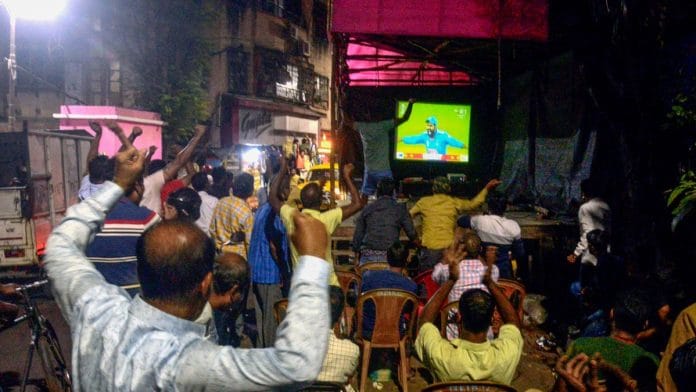It is a great time for cricket fans. India has just won the Champions Trophy and the Indian Premier League will begin in a few days. Cafes, kirana stores, barber shops, and restaurants will transform into mini stadiums and patrons will turn pundits. As you read this, advertisers, brands, and mobile application providers are working on bespoke marketing strategies to increase customer engagement.
At the backend of this carnival are TV broadcasters and digital streaming companies that acquire media rights from the Board of Cricket Control in India (BCCI) to bring on-field action to our screens. Broadcasters paid $2.4 billion for the previous five seasons in 2017, and in the most recent auction in 2022, broadcasters and streamers together paid more than double the amount.
The exceptional Indian TV market
While TV and digital rights were sold separately in the last auctions, each cost a little over $3 billion, a reflection of an equal value proposition of TV and streaming in India. TV has shown remarkable resilience here relative to other big markets.
In 2024, 546 million viewers saw the IPL on TV while an estimated 550-600 million viewed it on streaming services. Roughly 70 per cent of the viewers overlap, and watched IPL both on TV and digital. TV sustained momentum despite the fact that the viewers could view matches for free on phones. It’s not just the IPL, English Premier League football TV viewers doubled in cities last year too.
Around 125-135 million households pay for TV, and another 45 million pay a one-time installation fee to access free-to-air TV. With 67 per cent penetration, India is second only to China in the Asia-Pacific.
In other parts of the world like the US where a household pays $90 (Rs 7850 approximately) monthly for pay TV, viewers have migrated to streaming services to save on costs. But in India, pay TV remains an accessible and cost-effective option because most pay only Rs 200 – 400 per month.
Bundling TV and broadband also mitigates cord-cutting globally to an extent. This is why leading internet providers cross-subsidise and offer triple-play—broadband, TV, and streaming apps—at reasonable rates in India too.
Also read: India’s TV, radio industries are sinking. TRAI must address overregulation of legacy media
Bottlenecked monetisation
India’s exceptional media market, where linear and digital services coexist, already generates tremendous value for the sports ecosystem. But a lot more is possible to realise if media markets are freed from the legacy shackles of economic micromanagement.
TV channel prices remain the same whether you are watching the IPL or its highlights three months later. Today, broadcasters cannot monetise the ‘perceived value’ that consumers attach to exclusive access, high-quality programming, or unique immersive experiences because of regulatory restrictions on differential pricing. Broadcasters charge a four-member household the same as a cafe hosting a match screening for a hundred spectators. Each extra individual who watches TV at a screening is a broadcaster’s loss.
The Telecom Regulatory Authority of India (TRAI), which oversees broadcasting services, is likely going to rethink the need for other economic controls it exercises such as restrictions on pricing bundling of channels, as per a recent deposition by the regulator to a parliamentary committee. This is a positive step, but allowing differential pricing is also in order if TRAI wants TV markets to continue to keep in step with streaming. Similar copyrighted goods like software and music are charged based on use. If you purchase Microsoft Office, you can choose a plan that works for you or a more expensive plan suited to an office of five.
Also read: Here’s why BCCI took IPL auction to Saudi Arabia—cricket is not the main course
The best is yet to come
A BIF-CUTS survey of Indian TV consumers found that consumers are willing to pay more for TV in exchange for better quality of content and service. Regulations that act as a barrier to broadcasters meeting this demand, diminish consumer welfare and the growth prospects of both the TV and sports market along with it.
An ability to differentiate prices will mean that broadcasters can roll out pay-per-view options for in-demand live events that offer consumers additional features like expert analysis and exclusive interviews. Similarly, commercial establishments could benefit from dedicated, tailor-made feeds. For example, a gymkhana may want to watch Shillong Lajong FC play live, instead of the IPL final happening at the same time. Technological developments can enable limitless choice.
The year 1982 was an inflexion point for the symbiotic relationship between sports and TV in India; this was when Doordarshan’s first colour transmission coincided with the Asian Games hosted in New Delhi. It led to increased consumer demand for TV sets. Remarkably, sports, TV and viewers continue to be intertwined despite the internet, and there is no public interest rationale in retaining legacy regulations that get in the way of unfettered choice and innovation in this market.
The author is a media and telecom expert in Koan Advisory Group. Views are personal.
(Edited by Theres Sudeep)






